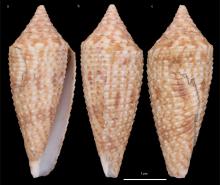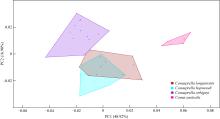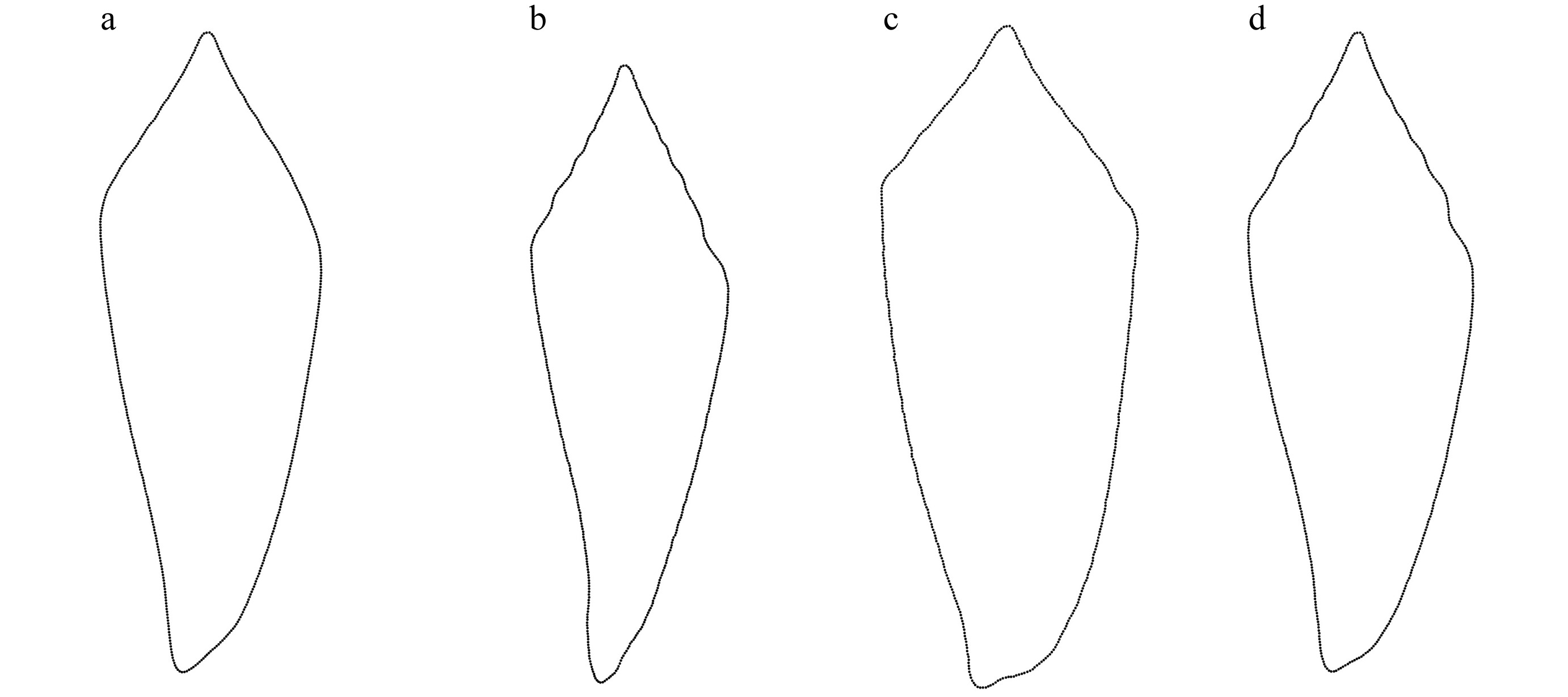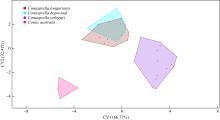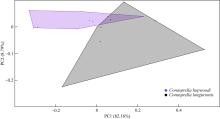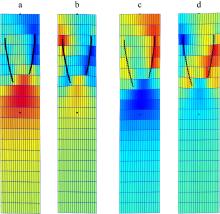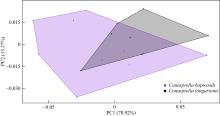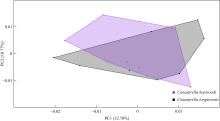Journal of Tropical Oceanography ›› 2025, Vol. 44 ›› Issue (4): 145-165.doi: 10.11978/2024165
• Marine Biology • Previous Articles Next Articles
Comparative study on Conasprella cones species in Chinese waters
HE Chen1,2( ), WANG Jianing1,2, CHEN Zhiyun1(
), WANG Jianing1,2, CHEN Zhiyun1( ), TAN Yehui1,2
), TAN Yehui1,2
- 1. Marine Biodiversity Collection of South China Sea, Guangdong Provincial Key Laboratory of Applied Marine Biology, South China Sea Institute of Oceanology, Chinese Academy of Sciences, Guangzhou 510301, China
2. University of Chinese Academy of Sciences, Beijing 100049, China
-
Received:2024-08-28Revised:2024-09-18Online:2025-07-10Published:2025-07-31 -
Contact:CHEN Zhiyun -
Supported by:Taxonomist Project, Chinese Academy of Sciences(CAS-TAX-24-043); National Animal Collection Resource Center, China
CLC Number:
- P735
Cite this article
HE Chen, WANG Jianing, CHEN Zhiyun, TAN Yehui. Comparative study on Conasprella cones species in Chinese waters[J].Journal of Tropical Oceanography, 2025, 44(4): 145-165.
share this article
Add to citation manager EndNote|Reference Manager|ProCite|BibTeX|RefWorks
Tab. 1
Conids specimens examined in this study"
| 物种 | 标本号 | 数量 | 采集地 | 采集人 | 采集时间 |
|---|---|---|---|---|---|
| 南方芋螺 Conus australis | SCSMBC006351 | 1 | 汕尾遮浪 | 林碧萍 | 1980-12-19 |
| 南方芋螺 Conus australis | SCSMBC008637 | 2 | 南海北部 | 晏磊 | 2016-09-09 |
| 南方芋螺 Conus australis | SCSMBC008638 | 1 | 东海南部拖网 | 王洋 | 2017-12 |
| 南方芋螺 Conus australis | SCSMBC008639 | 1 | 东海南部拖网 | 王洋 | 2017-12 |
| 昏芋螺 Conus comatosa | DH24070909 | 1 | 浙江东海120m水深拖网 | 何径 | 2010 |
| 昏芋螺 Conus comatosa | DH24070913 | 1 | 浙江东海120m水深拖网 | 何径 | 2010 |
| 昏芋螺 Conus comatosa | DH24070914 | 1 | 浙江东海120m水深拖网 | 何径 | 2010 |
| 龙王芋螺Conasprella ichinoseana | SCMSBC008640 | 1 | 东海南部150~180m泥沙海底拖网 | 南海所 | 2015-04 |
| 欧氏芋螺 Conasprella orbignyi | SCMSBC006413 | 1 | 汕尾遮浪 | 林碧萍 | 1980-12-19 |
| 欧氏芋螺 Conasprella orbignyi | SCMSBC008645 | 1 | 东海南部150~180m泥沙海底拖网 | 王洋 | 2018-03 |
| 欧氏芋螺 Conasprella orbignyi | SCMSBC008646 | 1 | 东海南部150~180m泥沙海底拖网 | 王洋 | 2018-03 |
| 欧氏芋螺 Conasprella orbignyi | SCMSBC008647 | 1 | 东海南部150~180m泥沙海底拖网 | 王洋 | 2018-03 |
| 欧氏芋螺 Conasprella orbignyi | DH24070901 | 1 | 东海南部海底拖网 | 何径 | 2010s |
| 欧氏芋螺 Conasprella orbignyi | DH24070902 | 1 | 东海南部海底拖网 | 何径 | 2010s |
| 欧氏芋螺 Conasprella orbignyi | DH24070903 | 1 | 东海南部海底拖网 | 何径 | 2010s |
| 欧氏芋螺 Conasprella orbignyi | DH24070904 | 1 | 东海南部海底拖网 | 何径 | 2010s |
| 欧氏芋螺 Conasprella orbignyi | DH24070905 | 1 | 东海南部海底拖网 | 何径 | 2010s |
| 欧氏芋螺 Conasprella orbignyi | DH24070906 | 1 | 东海南部海底拖网 | 何径 | 2010s |
| 欧氏芋螺 Conasprella orbignyi | DH24070907 | 1 | 东海南部海底拖网 | 何径 | 2010s |
| 欧氏芋螺 Conasprella orbignyi | DH24070908 | 1 | 东海南部海底拖网 | 何径 | 2010s |
| 欧氏芋螺 Conasprella orbignyi | DH24070909 | 1 | 东海南部海底拖网 | 何径 | 2010s |
| 欧氏芋螺 Conasprella orbignyi | DH24070911 | 1 | 东海南部海底拖网 | 何径 | 2010s |
| 欧氏芋螺 Conasprella orbignyi | DH24070912 | 1 | 东海南部海底拖网 | 何径 | 2010s |
| 郝伍德芋螺Conasprella hopwoodi | SCSMBC006302 | 1 | 汕尾遮浪 | 南海海洋研究所 | 1980-12-19 |
| 郝伍德芋螺Conasprella hopwoodi | SCSMBC006314 | 1 | 汕尾遮浪 | 南海海洋研究所 | 1980-12-19 |
| 郝伍德芋螺Conasprella hopwoodi | SCSMBC006315 | 1 | 汕尾遮浪 | 南海海洋研究所 | 1980-12-19 |
| 郝伍德芋螺Conasprella hopwoodi | SCSMBC006323 | 1 | 汕尾遮浪 | 南海海洋研究所 | 1980-12-19 |
| 郝伍德芋螺Conasprella hopwoodi | SCSMBC006325 | 1 | 汕尾遮浪 | 南海海洋研究所 | 1980-12-19 |
| 郝伍德芋螺Conasprella hopwoodi | SCSMBC006326 | 1 | 汕尾遮浪 | 南海海洋研究所 | 1980-12-19 |
| 郝伍德芋螺Conasprella hopwoodi | SCSMBC006327 | 1 | 汕尾遮浪 | 南海海洋研究所 | 1980-12-19 |
| 郝伍德芋螺Conasprella hopwoodi | SCSMBC006331 | 1 | 汕尾遮浪 | 南海海洋研究所 | 1980-12-19 |
| 郝伍德芋螺Conasprella hopwoodi | SCSMBC006367 | 1 | 汕尾遮浪 | 南海海洋研究所 | 1980-12-19 |
| 郝伍德芋螺Conasprella hopwoodi | SCSMBC006368 | 1 | 汕尾遮浪 | 南海海洋研究所 | 1980-12-19 |
| 郝伍德芋螺Conasprella hopwoodi | SCSMBC006369 | 1 | 汕尾遮浪 | 南海海洋研究所 | 1980-12-19 |
| 柳斑芋螺 Conasprella longurionis | SCMSBC006334 | 1 | 汕尾遮浪 | 南海海洋研究所 | 1980-12-19 |
| 柳斑芋螺 Conasprella longurionis | SCMSBC006335 | 1 | 汕尾遮浪 | 南海海洋研究所 | 1980-12-19 |
| 柳斑芋螺 Conasprella longurionis | SCMSBC006343 | 1 | 汕尾遮浪 | 南海海洋研究所 | 1980-12-19 |
| 柳斑芋螺 Conasprella longurionis | SCMSBC006348 | 1 | 汕尾遮浪 | 南海海洋研究所 | 1980-12-19 |
| 柳斑芋螺 Conasprella longurionis | SCMSBC006354 | 1 | 汕尾遮浪 | 南海海洋研究所 | 1980-12-19 |
| 柳斑芋螺 Conasprella longurionis | SCMSBC006355 | 1 | 汕尾遮浪 | 南海海洋研究所 | 1980-12-19 |
| 柳斑芋螺 Conasprella longurionis | SCMSBC006359 | 1 | 汕尾遮浪 | 南海海洋研究所 | 1980-12-19 |
| 柳斑芋螺 Conasprella longurionis | SCMSBC006360 | 1 | 汕尾遮浪 | 南海海洋研究所 | 1980-12-19 |
| 柳斑芋螺 Conasprella longurionis | SCMSBC006361 | 1 | 汕尾遮浪 | 南海海洋研究所 | 1980-12-19 |
| 柳斑芋螺 Conasprella longurionis | SCMSBC006362 | 1 | 汕尾遮浪 | 南海海洋研究所 | 1980-12-19 |
| 柳斑芋螺 Conasprella longurionis | SCMSBC006364 | 1 | 汕尾遮浪 | 南海海洋研究所 | 1980-12-19 |

Fig. 1
Landmarks and semi-landmarks of cone shells. (a) Apex (landmark 1), base (landmark 2), spiral sculpture on both sides of the body whorl (landmarks 3−42); (b) spiral ribs on the upper-middle portion of the body whorl (landmarks 1−38); (c) apex (landmark 1), base (landmark 2), suture line (landmarks 3−12); (d) aperture top (landmark 1), base (landmark 2), both sides of the aperture (semi-landmarks 3−22)"

Tab. 2
Eigenvalues, explained variance, and cumulative explained variance of the first five principal components for the outline geometric morphology of Conasprella longurionis, Conasprella hopwoodi, Conasprella orbignyi, and Conus australis"
| 主成分 | 特征值 | 解释总体变异比例/% | 累计变异比例/% |
|---|---|---|---|
| 1 | 0.0006444 | 48.917 | 48.917 |
| 2 | 0.0002237 | 16.981 | 65.898 |
| 3 | 0.0001458 | 11.069 | 76.967 |
| 4 | 0.0000740 | 5.615 | 82.582 |
| 5 | 0.0000427 | 3.245 | 85.827 |
Tab. 4
Eigenvalues, percentage of variance, and cumulative variance for the first four principal components of spiral rib geometric morphology on the body whorl of Conasprella longurionis and Conasprella hopwoodi"
| 主成分 | 特征值 | 解释总体变异比例/% | 累计变异比例/% |
|---|---|---|---|
| 1 | 0.0478982 | 82.155 | 82.155 |
| 2 | 0.00512319 | 8.787 | 90.942 |
| 3 | 0.001751 | 3.003 | 93.946 |
| 4 | 0.00106792 | 1.832 | 95.777 |
Tab. 6
Eigenvalues, percentage of explained variance, and cumulative variance for the first four principal components of spire geometric morphology in Conasprella longurionis and Conasprella hopwoodi"
| 主成分 | 特征值 | 解释总体变异比例/% | 累计变异比例/% |
|---|---|---|---|
| 1 | 0.001365 | 70.920 | 70.920 |
| 2 | 0.000256 | 13.273 | 84.193 |
| 3 | 0.000134 | 6.939 | 91.132 |
| 4 | 0.000078 | 4.050 | 95.182 |
Tab. 8
Eigenvalues, percentage of explained variance, and cumulative variance for the first five principal components of aperture geometric morphology in Conasprella longurionis and Conasprella hopwoodi"
| 主成分 | 特征值 | 解释总体变异比例/% | 累计变异比例/% |
|---|---|---|---|
| 1 | 0.000120845 | 32.701 | 32.701 |
| 2 | 0.0000693704 | 18.772 | 51.473 |
| 3 | 0.0000602704 | 16.309 | 67.782 |
| 4 | 0.0000291218 | 7.880 | 75.662 |
| 5 | 0.0000164304 | 4.446 | 80.108 |
| [1] |
白明, 杨星科, 李静, 等, 2014. 几何形态学: 关于形态定量比较的科学计算工具[J]. 科学通报, 59(10): 887-894.
|
|
|
|
| [2] |
蔡英亚, 刘桂茂, 1989. 广东西部沿海的贝类[J]. 湛江水产学院学报, 9(1-2): 57-78, 87.
|
|
|
|
| [3] |
陈新军, 方舟, 陈洋洋, 等, 2017. 几何形态测量学在水生生物中的应用[M]. 北京: 科学出版社.
|
|
|
|
| [4] |
陈志云, 连喜平, 谭烨辉, 2019. 南海芋螺科一新记录(腹足纲,芋螺科)[J]. 热带海洋学报, 38(4): 59-63.
doi: 10.11978/2018109 |
|
|
|
| [5] |
陈志云, 谭烨辉, 连喜平, 2016. 中国海芋螺属一新记录(腹足纲, 芋螺科)[J]. 热带海洋学报, 35(3): 99-100.
doi: 10.11978/2015089 |
|
|
|
| [6] |
葛德燕, 夏霖, 吕雪霏, 等, 2012. 几何形态学方法及其在动物发育与系统进化研究中的应用[J]. 动物分类学报, 37(2): 296-304.
|
|
|
|
| [7] |
金武, 马学艳, 彭刚, 等, 2024. 梨形环棱螺11个地理种群的几何形态学分析[J]. 中国农学通报, 40(2): 159-164.
doi: 10.11924/j.issn.1000-6850.casb2023-0093 |
|
|
|
| [8] |
何晨, 陈志云, 谭烨辉, 2024. 黑芋螺和其近似种的特征比较[J]. 热带生物学报, 15(3): 349-353.
|
|
|
|
| [9] |
李凤兰, 1995. 中国近海芋螺科的研究Ⅱ[J]. 海洋科学集刊, 36: 245-266, 319-322.
|
|
|
|
| [10] |
李凤兰, 林民玉, 2016. 中国动物志无脊椎动物 (第五十五卷) 软体动物门腹足纲芋螺科[M]. 北京: 科学出版社: 11-286, pls. 1-4, figs. 1-168
|
|
|
|
| [11] |
李浩楠, 毛楷林, 熊洋, 等, 2020. α-芋螺毒素LvIA特定氨基酸的突变对其活性的影响[J]. 中国海洋药物, 39(6): 45-51.
|
|
|
|
| [12] |
李晓丹, 油珅, 罗素兰, 等, 2020. α-芋螺毒素TxIB抗药物依赖的初步探索[J]. 中国海洋药物, 39(6): 39-44.
|
|
|
|
| [13] |
罗雪, 赵元龙, 陈圣光, 等, 2023. 贵州剑河寒武系苗岭统凯里组太阳女神螺类几何形态学研究[J]. 古生物学报, 62(1): 78-97.
|
|
|
|
| [14] |
舒予, 史令, 郝振林, 等, 2022. 几何形态学对8种扇贝的形态分类的应用[J]. 海洋科学, 46(6): 61-69.
|
|
|
|
| [15] |
张素萍, 2008. 中国海洋贝类图鉴[M]. 北京: 海洋出版社 (in Chinese).
|
| [16] |
|
| [17] |
|
| [18] |
|
| [19] |
|
| [20] |
|
| [21] |
|
| [22] |
|
| [23] |
|
| [24] |
|
| [25] |
|
| [26] |
|
| [27] |
|
| [28] |
|
| [29] |
|
| [30] |
doi: 10.1016/j.ympev.2010.11.020 pmid: 21147238 |
| [31] |
|
| [32] |
|
| [33] |
|
| [34] |
|
| [35] |
|
| [36] |
|
| [37] |
|
| [38] |
|
| [39] |
MOLLUSCABASE, 2019. MolluscaBase. ConasprellaThiele, 1929 [DB/OL]//World Register of Marine Species. (2019-01-11) [2024-05-25]. https://www.marinespecies.org/aphia.php?p=taxdetails&id=428971
|
| [40] |
MOLLUSCABASE, 2022. MolluscaBase. Conidae J. Fleming, 1822 [DB/OL]//World Register of Marine Species. (2022-03-26) [2024-05-25]. https://www.marinespecies.org/aphia.php?p=taxdetails&id=14107
|
| [41] |
|
| [42] |
|
| [43] |
|
| [44] |
|
| [45] |
|
| [46] |
|
| [47] |
doi: 10.1016/j.ympev.2014.05.023 pmid: 24878223 |
| [48] |
|
| [49] |
pmid: 26300576 |
| [50] |
pmid: 21712968 |
| [51] |
|
| [52] |
|
| [53] |
doi: 10.11646/zootaxa.4441.3.3 pmid: 30313996 |
| [54] |
|
|
|
|
| [55] |
|
| [56] |
|
| [57] |
|
| [58] |
|
| [59] |
doi: 10.1093/sysbio/syt002 pmid: 23325808 |
| [60] |
|
| [61] |
|
| [62] |
|
| [63] |
|
| [64] |
|
| [65] |
|
| [66] |
|
| [67] |
|
| [68] |
|
| [69] |
|
| [1] | ZHOU Zhiqian, LIAN Xiping, TAN Yehui. Morphological characteristics of a newly recorded species of the genus Stylocheiron (Euphausiidae) from the South China Sea* [J]. Journal of Tropical Oceanography, 2025, 44(3): 66-71. |
| [2] | ZHOU Zhiqian, LIAN Xiping, TAN Yehui. Taxonomic research of the genus Hansarsia from the South China Sea* [J]. Journal of Tropical Oceanography, 2025, 44(2): 100-114. |
| [3] | HE Chen, CHEN Zhiyun, TAN Yehui. Two new records of Neogastropoda (Mollusca, Gastropoda) from the Nansha Islands of China [J]. Journal of Tropical Oceanography, 2024, 43(6): 140-144. |
| [4] | HUO Jiaxin, LI Yingxin, SONG Yan, ZHU Qing, ZHOU Weihua, YUAN Xiangcheng, HUANG Hui, LIU Sheng. Complete mitochondrial genome of Cladopsammia gracilis and Rhizopsammia wettsteini (Scleractinia, Dendrophylliidae) and its phylogenetic implications* [J]. Journal of Tropical Oceanography, 2024, 43(3): 22-30. |
| [5] | CHEN Zhiyun, GUO Xiang, LIU Yi, WEI Peng, ZHANG Suping. A new record of genus Cuspivolva (Mollusca, Gastropoda, Ovulidae) in coastal waters off Xiamen [J]. Journal of Tropical Oceanography, 2022, 41(2): 189-192. |
| [6] | LIU Jinmei, JIANG Jingjing, MA Xin, HUANG Bingxin, YANG Nan, LIU Meiyuan, DING Lanping. Morphological taxonomy of genus Hypnea (Rhodophyta, Gigartinales) from eastern Guangdong, China [J]. Journal of Tropical Oceanography, 2021, 40(1): 99-110. |
| [7] | Zhiyun CHEN,Xiping LIAN,Yehui TAN. A new record of Conidae from the South China Sea (Mollusca, Gastropoda, Neogastropoda) [J]. Journal of Tropical Oceanography, 2019, 38(4): 59-63. |
| [8] | Zhiyun CHEN, Xiping LIAN, Yehui TAN. Comparative study on several confused species of Nerita (Gastropoda, Cycloneritimorpha, Neritidae) [J]. Journal of Tropical Oceanography, 2018, 37(3): 73-79. |
| [9] | Huanchang DONG, Chunxiu HUANG, Guoshuang XU, Yang LI. Studies on intraspecies diversity of Pseudo-nitzschia pungens from Chinese coastal waters* [J]. Journal of Tropical Oceanography, 2018, 37(1): 12-19. |
| [10] | Zhiyun CHEN, Xiping LIAN, Yehui TAN. One new record of Turridae (Mollusca, Gastropoda, Neogastropoda) from China seas [J]. Journal of Tropical Oceanography, 2017, 36(1): 92-94. |
| [11] | CHEN Zhiyun, TAN Yehui, LIAN Xiping. A new record of Conus (Gastropoda, Conidae) from China seas [J]. Journal of Tropical Oceanography, 2016, 35(3): 99-100. |
| [12] | WANG Xulei, WANG Guangce, XIA Bangmei. A new record of genus Gelidium in the Xisha Islands of China, G. pusillum var. pacificum Taylor (Gelidiales, Rhodophyta) [J]. Journal of Tropical Oceanography, 2016, 35(2): 76-82. |
| [13] | CHEN Zhi-yun, TAN Ye-hui, LIAN Xi-ping. Taxonomic note on the Lineate Nerite: Nerita balteata Reeve, 1855 (Gastropoda, Neritidae, Nerita) [J]. Journal of Tropical Oceanography, 2015, 34(4): 74-76. |
| [14] | DING Lan-ping, ZHONG Li-min, TAN Hua-qiang, HUANG Bing-xin. A morphological study on marine red algal Polysiphonia scopulorum var. villum [J]. Journal of Tropical Oceanography, 2015, 34(1): 42-48. |
|
||












